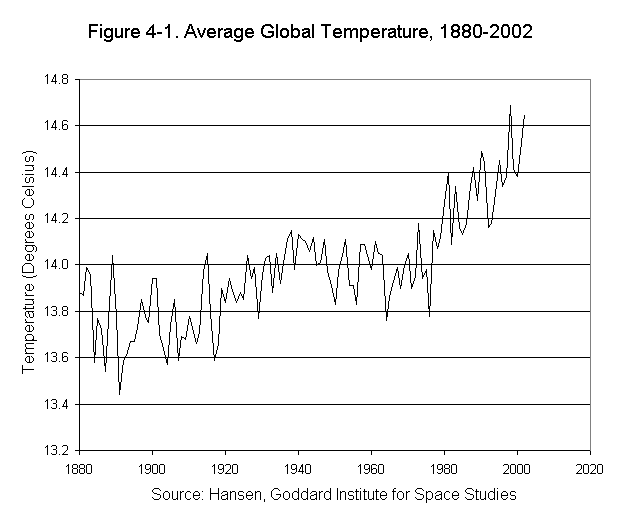"World on Edge details the vice closing around us: a quadruple squeeze of global warming and shortages in food, water and energy. Then it explains the path out—and how little time we have left to take that path. Got anything more important to read than that?" —Peter Goldmark, former head of the Port authority of New York and New Jersey, President of the Rockefeller Foundation, and CEO of the International Herald Tribune
Chapter 4. Rising Temperatures and Rising Seas: The Temperature Record
Scientists at NASA's Goddard Institute for Space Studies gather data from a global network of some 800 climate-monitoring stations to measure changes in the earth's average temperature. Their temperature records go back 123 years, to 1880.3
From 1880 to 1930, the global temperature for almost every year was below the norm (which scientists define as the average from 1950 to 1980). During the 1930s, the first decade when there were several years above the norm, this pattern began to change. It brought record temperatures and drought to the U.S. Great Plains, helping to create the Dust Bowl.4
Beginning in 1977, the temperature began to climb and it has been above the norm each year since then. During the 1980s, the average global temperature was 0.26 degrees Celsius above; during the 1990s, it averaged 0.40 degrees above the norm. And during the first three years of the new century, the average temperature has been 0.55 degrees above the norm. If the accelerating rise continues, the jump in this decade will substantially exceed that of each of the preceding ones.5
Meteorologists note that the 16 warmest years on record have come since 1980. And since the three warmest years on record have come in the last five years, not only is the earth's temperature rising, but the rise is accelerating. (See Figure 4-1.) Against this backdrop of record increases, the projections of the Intergovernmental Panel on Climate Change (IPCC) that the earth's average temperature will rise 1.4-5.8 degrees Celsius (2.5-10.4 degrees Fahrenheit) during the current century seem all too possible. The IPCC upper-end projected increase of 5.8 degrees Celsius during this century is comparable to the change registered between the last Ice Age and today. Whether the world's temperature trend is more likely to follow the lower or the upper projection, no one knows. But given the recent acceleration in the rise, we may now be on a trajectory that is much closer to the upper end of the range.6
At a practical level, the projected rise in temperature of 1.4-5.8 degrees Celsius is a global average. In reality, the rise will be very uneven. It will be much greater over land than over oceans, in the higher latitudes than over the equator, in the continental interior than in coastal regions. James J. McCarthy, Harvard professor of biological oceanography and co-chair of an IPCC working group, notes that while global average temperature rose roughly 1 degree Fahrenheit during the century that just ended, on Alaska's north slope and in northwestern Canada it rose by 4-7 degrees Fahrenheit (2.2-3.9 degrees Celsius), several times the global average.7
ENDNOTES:
3. Data from J. Hansen, NASA's Goddard Institute for Space Studies (GISS), "Global Temperature Anomalies in .01 C," at www.giss.nasa.gov/data/update/gistemp, viewed 28 April 2003; weather stations used from Reto A. Ruedy, GISS, e-mail to Janet Larsen, Earth Policy Institute, 14 May 2003.
4. Hansen, op. cit. note 3.
5. Ibid.
6. Figure 4-1 from ibid.; Intergovernmental Panel on Climate Change (IPCC), Climate Change 2001: The Scientific Basis. Contribution of Working Group I to the Third Assessment Report of the Intergovernmental Panel on Climate Change (New York: Cambridge University Press, 2001); comparison to time since Ice Age from Warren Washington, cited in Stephen Phillips, "Ignoring Climate Will Land Us in Hot Water," Times Higher Education Supplement, 7 February 2003.
7. Ibid.; McCarthy from Jonathan Shaw, "The Great Global Experiment," Harvard Magazine, November-December 2002, p. 35.
Copyright © 2003 Earth Policy Institute


